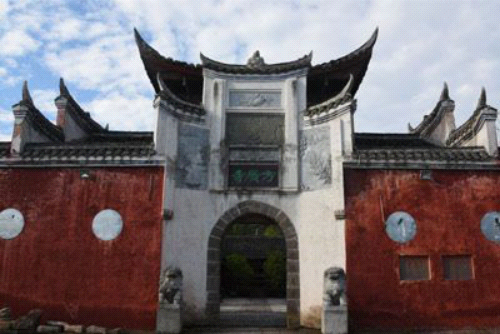
Fangguang Temple was built during the Song Dynasty (960-1279) on Feishan Mountain in the west of Jingzhou City. It stands against Baoding, the peak of the mountain, facing east. Ancient cypresses and ginkgoes are planted in front of the temple, surrounded by flat and open land with thousands of acres of fertile fields and lush forests. The temple is 79 meters in length from north to south and 34 meters in width from east to west, with a total gross floor area of 852.8 square meters. It has four sections along its central axis. The first section is the mountain gate, with a small courtyard inside and inscribed stone corridors on both sides. The second section is a hall, a wooden structure with three openings and a gable-and-hip roof. The middle opening serves as a passage with the Four Heavenly Kings enshrined on the two sides. There are side rooms with curved roofs on both sides, and a courtyard in the middle. The third section is the main hall, the center of the temple, with seven rooms, featuring a double-eaves hip-and-gable roof and surrounded by corridors. There is a moon platform in front of the hall, where large-scale sacrificial activities are held. The fourth section includes the rear hall and side rooms. The temple is spacious, with magnificent halls. Behind the main hall, there are Lingguan Hall, Yuhuang Tower, and Pilu Temple, as well as Banshan Pavilion, Xiaotianmen Temple, Datianmen Temple, and Mozhen Nunnery, forming a temple complex. There are more than ten monks and nuns living in the temple. Every second, sixth, and ninth month of the lunar calendar, pilgrims make it a sacred Buddhist site. However, the temple has suffered repeated damage. It was repaired in the early years of the Hongwu reign (1368-1398) and renamed Yuantian Palace, but was later robbed by bandits. It underwent repairs in 1783 (the 28th year of Emperor Qianlong’s reign in the Qing Dynasty), but was again robbed by bandits. Since then, the temple has fallen into disrepair, yet retained its former charm. Many poets and scholars have inscribed poems here. In 1983, it was rated as a county-level cultural relics protection unit. In 1993, the temple underwent renovations, and the halls were restored, with over 20 statues of gods resculpted. By 1997, the temple occupied an area of 3,000 square meters, with a building area of 620 square meters. There are two monks and over 200 converts. During the second, sixth, and ninth months of the lunar calendar, more than ten thousand pilgrims from the Hunan-Guizhou border region come to the temple to worship Buddha. It has gradually become one of the Buddhist activity centers. In 2019, the temple was rated one of provincial cultural relics protection units in Hunan Province.
(Translated by Yang Hong)
